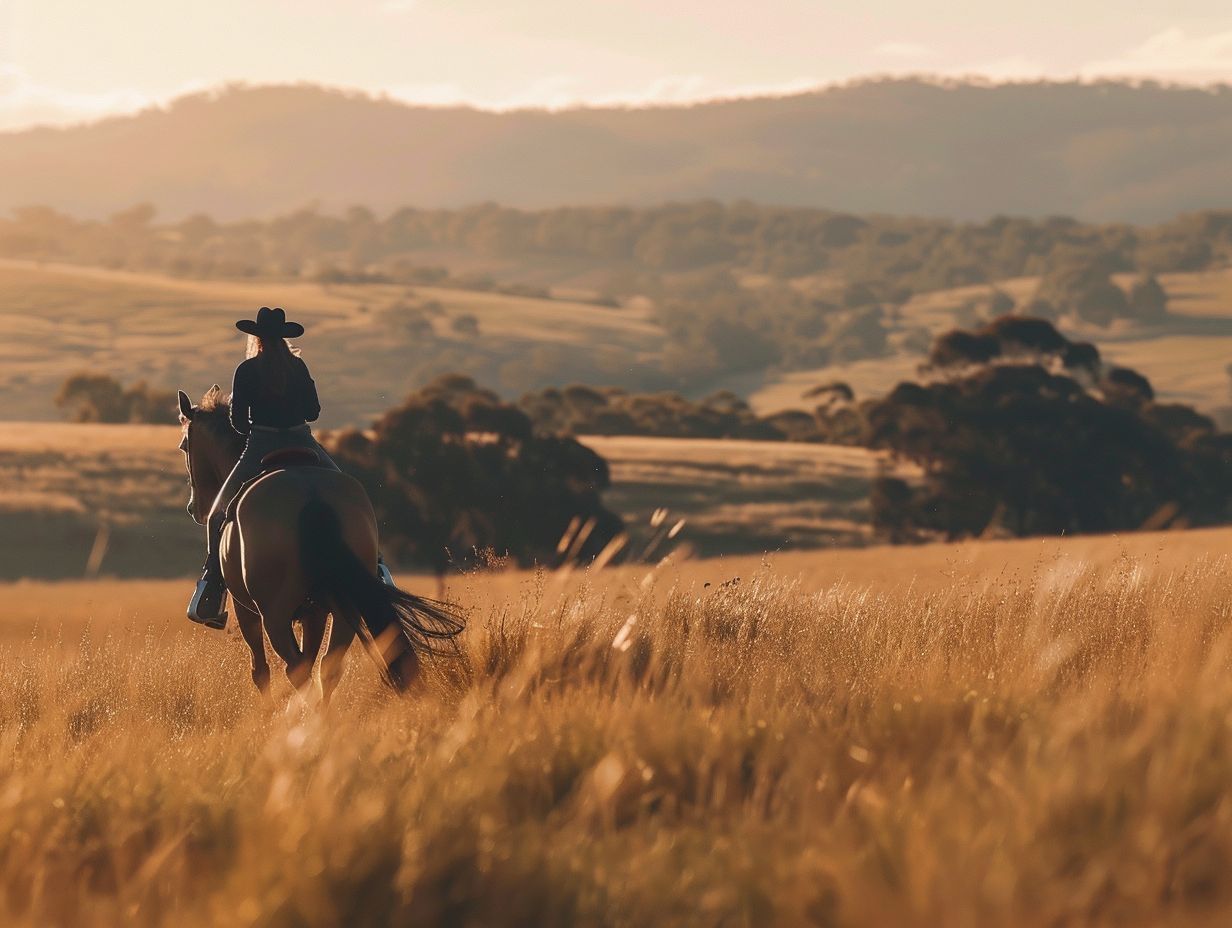If you are considering leasing a horse but are unsure of where to begin, this article aims to offer you a thorough understanding of the horse leasing process.
From recognizing the advantages of horse leasing to selecting a suitable horse based on your riding proficiency, negotiating the terms of the lease agreement, tending to your leased horse, and concluding the lease, all aspects of the process will be detailed.
Prepare yourself for this thrilling expedition into the realm of horse leasing and get ready to ride!
Leasing a Horse: An Overview

Leasing a horse provides you with an excellent opportunity to enjoy the companionship and benefits of horse ownership without the full-time commitment and financial investment required to own a horse. It allows you to experience the joys of horse riding, care, and training while also sharing responsibilities with the horse’s owner.
Opting for a horse lease enables you to savor the equestrian lifestyle, involving regular interactions with these majestic animals and engaging in various equestrian activities. This arrangement not only allows you to develop a deep bond with a horse companion but also provides the opportunity to participate in events and competitions without shouldering the entire cost of ownership. Leasing offers flexibility to explore different horse breeds, temperaments, and skill levels, contributing to overall learning and personal growth within the equestrian community.
Understanding Horse Leasing
To understand horse leasing, you need to familiarize yourself with the leasing agreement, lease contract, lease terms, lease cost, and lease period. A thorough understanding of these elements is crucial for establishing a smooth and mutually beneficial leasing arrangement.
In a horse leasing agreement, the lease contract delineates the specific terms and conditions that have been mutually agreed upon by the lessor and lessee. These terms typically encompass the responsibilities of each party, the authorized use of the horse, any insurance prerequisites, and provisions for the horse’s care and maintenance.
It is imperative to comprehend the lease cost, which includes the fees for the lease itself along with any additional expenses such as veterinary care, farrier services, and boarding. The lease period specifies the duration during which the horse will be in the lessee’s custody, and it is vital to adhere to this timeline to prevent any disputes or misunderstandings.
Benefits of Leasing a Horse
When considering horse leasing, you benefit from various advantages such as cost savings, flexibility, and the chance to experience horse ownership without a long-term commitment. Before entering into a leasing agreement, it is important to carefully assess the associated risks and factors.
One of the notable financial advantages of horse leasing is its cost-effectiveness compared to outright purchasing. Opting for a lease eliminates the need for the initial capital investment required when buying a horse, along with ongoing expenses like boarding, veterinary care, and training. This affordability widens the accessibility of horse ownership to a broader range of equestrians, allowing them to revel in the joys of riding and caring for a horse without bearing the full financial burden.
Leasing offers a degree of flexibility that may not be found in traditional ownership setups. Riders can choose a horse that aligns with their skill level and objectives at a specific point in their equestrian journey, all without the enduring commitment or obligations associated with ownership. This flexibility is especially advantageous for individuals who may not be prepared for the full-time commitment of owning a horse due to time constraints, financial constraints, or other considerations.
Despite the benefits, potential leasers should be mindful of the risks involved in horse leasing. Thoroughly vetting the horse, lessor, and lease terms is crucial to ensure that the arrangement is mutually beneficial. Factors such as the horse’s health, behavior, training level, and suitability for the rider’s needs must be carefully evaluated to prevent potential issues in the future. Clear communication and a well-structured contract are vital to delineate each party’s responsibilities, expectations, and potential liabilities.
By thoughtfully considering the advantages and risks of horse leasing, individuals can make an informed decision that aligns with their equestrian objectives and overall financial position.
Cost Savings and Flexibility
One of the primary benefits of horse leasing is the cost savings it offers compared to full ownership. You can enjoy this cost-effective option by choosing to lease a horse rather than purchasing one outright. Leasing provides flexibility in terms of selecting horse facilities, equipment, and tack based on your individual preferences and requirements.
Opting for a lease arrangement helps you avoid the significant upfront costs associated with purchasing a horse outright, making it a more financially feasible option for many equestrians. Leasing allows you to choose different facilities for boarding, access specialized equipment as needed, and customize the type of tack used for riding, enhancing the overall experience. This flexibility enables you to tailor your horse-owning experience to meet your specific needs while also saving money in the process.
Finding the Right Horse to Lease
When looking for the right horse to lease, consider factors such as horse breed, temperament, behavior, and age. Match the horse’s characteristics with your riding experience level, whether you are an experienced rider or a beginner. It is important to select a horse that not only matches your riding abilities but also complements your riding style and preferences.
For instance, if you enjoy leisurely trail rides, a calm and reliable horse with a gentle temperament may be ideal. Conversely, if you aim to participate in competitive events, a horse with agility and athleticism would be more appropriate. Understanding how a horse’s breed, temperament, and behavior align with your requirements is key to ensuring a positive and fulfilling leasing experience.
Assessing Your Riding Level

When finding the right horse to lease, it is crucial for you to assess your riding level. Whether you are an experienced rider with a history of horse competitions and shows or a beginner seeking horse riding lessons, it is essential to match your skill level with the leased horse’s temperament for a successful partnership.
Your past experiences in competitions, lessons, and shows can provide valuable insights into your abilities and preferences as a rider. These events can help you gain an understanding of your strengths and areas for improvement, which can be beneficial in selecting a compatible horse.
For example, if you have a background in competitive show jumping, you may prefer a horse with more energy and responsiveness. Conversely, if you are new to riding and focusing on foundational skills, a calm and patient horse may be a better fit for your learning journey.
Factors to Consider in a Horse
When evaluating a potential leased horse, factors such as breed, temperament, behavior, and age play a significant role in determining compatibility with the rider. Understanding these characteristics ensures a harmonious and enjoyable leasing experience.
It is essential to consider breed-specific traits, as different breeds possess distinct strengths and weaknesses. For example, a Quarter Horse is recognized for its agility and speed, making it a suitable choice for Western riding disciplines, whereas a Warmblood may excel in dressage due to its elegant movement.
Another crucial factor to assess is temperament; some riders may prefer a calm and gentle horse, while others may thrive with a more spirited and energetic companion. Behavior patterns, such as responsiveness to cues and willingness to work, can also impact the rider’s experience.
Age-related considerations, such as the horse’s energy level and training stage, should align with the rider’s goals and skill level for a successful lease arrangement.
Negotiating the Lease Agreement
When negotiating a lease agreement, you need to pay close attention to various aspects of the process. This includes meticulously completing the application, securing approval for the lease, defining payment terms, familiarizing yourself with termination clauses, and exploring potential lease renewal options. Striving for clarity and establishing mutual understanding between all parties involved is crucial for ensuring a successful leasing arrangement.
Throughout the application process, it is imperative that you provide accurate details regarding your experience and intentions regarding the horse lease. Maintaining open and clear communication with the lessor is essential post-submission to address any inquiries or issues promptly. Once the lease approval is obtained, it is important for both parties to mutually agree on precise payment terms to prevent any potential misunderstandings. Understanding the termination clauses, including early exit penalties or notice period requirements, is vital for managing expectations effectively. Engaging in discussions about renewal possibilities from the outset can pave the way for future collaborations and facilitate a seamless transition if both parties opt to extend the lease agreement.
Key Terms and Conditions to Include
When entering into a horse lease agreement, you must pay attention to several key terms and conditions. These include the lease duration, the responsibilities of each party, insurance coverage, maintenance requirements, and any specific obligations for riders. A well-defined agreement is crucial to ensure that both parties fully comprehend their roles and obligations.
It is essential to provide clarity on the lease duration to avoid any confusion regarding the agreement’s start and end dates. Additionally, specifying the responsibilities of both parties – the lessor and the lessee – concerning the care, feeding, veterinary services, and other duties during the lease period is crucial.
The agreement should also explicitly outline the insurance provisions, such as identifying who is accountable for providing coverage for the horse in cases of illness, injury, or accidents. Clearly stating maintenance requirements like farrier and dental care can help prevent disputes in the future.
Caring for a Leased Horse
Caring for a leased horse involves attention to horse care practices such as maintaining the horse’s health, providing proper feeding and grooming, ensuring regular exercise, and scheduling veterinary check-ups. Upholding these standards contributes to the well-being and happiness of the leased horse.
Regular grooming is a key part of caring for a leased horse, as it helps to keep their coat clean and free from tangles. Brushing the horse regularly not only maintains their appearance but also promotes circulation and skin health. Along with grooming, ensuring the horse’s feeding schedule is consistent and meets their nutritional needs is crucial. Adequate exercise is another vital component to ensure the horse stays fit and mentally stimulated. Regular check-ups with a veterinarian help monitor the horse’s health and address any issues promptly, ensuring they receive proper care.
Responsibilities and Expectations

Understanding your responsibilities and expectations as a lessee involves managing horse facilities, selecting appropriate equipment and tack, maintaining grooming standards, ensuring proper feeding practices, and implementing a regular exercise routine. Meeting these responsibilities fosters a positive relationship with the leased horse.
Proper facility management includes maintaining clean stalls, regularly checking for any hazards, and ensuring a safe pasture environment. Regarding equipment selection, it’s crucial to have well-fitting saddles, bridles, and grooming tools to keep the horse comfortable and healthy. Grooming routines should include daily brushing, hoof care, and regular bathing to maintain the horse’s hygiene and appearance. Following a balanced feeding protocol tailored to the horse’s needs and monitoring water intake are essential for the horse’s overall health and vitality. Establishing an appropriate exercise regimen that includes a mix of groundwork, riding, and turnout ensures the horse remains physically and mentally engaged.
Ending the Lease
When ending a horse lease, you need to carefully consider termination procedures, renewal options, and fulfilling final lease responsibilities. It is crucial to prioritize clear communication and strict adherence to the lease agreement terms when wrapping up a leasing arrangement.
As you approach the conclusion of a horse lease, as the lessor, your first step should be to thoroughly review the terms specified in the original agreement to fully understand the specific requirements for termination. It is essential to initiate early communication with the lessee regarding the decision to terminate the lease, allowing ample time for proper planning. Discussing any potential renewal options or extensions can aid both parties in evaluating their future plans and making well-informed decisions. By fulfilling any outstanding lease responsibilities, such as settling any pending payments or arranging for the return of leased equipment, you can ensure a seamless transition and uphold a positive relationship between you as the lessor and the lessee.
Procedures and Considerations
When ending a horse lease, carefully consider termination procedures, evaluate associated expenses, and adhere to established guidelines to ensure a seamless conclusion. Making informed decisions and following the appropriate protocols are essential for a successful lease termination.
To begin the termination process, you should communicate openly with the other party involved to discuss the reasons for ending the lease and any relevant terms outlined in the contract. Transparency is key in ensuring that both parties understand the circumstances surrounding the lease conclusion.
Financial considerations such as outstanding payments, fees for early termination, and responsibilities for care and maintenance during the transition period should be clearly addressed. It is important to review the lease agreement thoroughly to ascertain any specific requirements for ending the lease, such as notice periods or formal written notifications.
Frequently Asked Questions
What is the process for leasing a horse?
The process for leasing a horse typically involves finding a suitable horse, negotiating lease terms, signing a lease agreement, and paying a security deposit. It is important to thoroughly research and visit potential horses before making a decision.
What are the different types of horse leases?

There are several types of horse leases, including full lease, partial lease, and free lease. In a full lease, the lessee has full use of the horse and is responsible for all expenses. In a partial lease, the lessee shares use and expenses with the owner. In a free lease, the horse is leased for a specific period of time without any financial exchange.
What should be included in a horse lease agreement?
A horse lease agreement should include details such as the lease term, the responsibilities of both the owner and lessee, the lease fee and payment schedule, and any restrictions or conditions. It is important to have a written contract to avoid any misunderstandings or disputes.
What expenses are typically covered in a horse lease?
In a full lease, the lessee is responsible for all expenses, including board, feed, vet bills, and farrier care. In a partial lease, the expenses are divided between the owner and lessee. In a free lease, the owner usually covers the majority of expenses.
Can I insure a leased horse?
Yes, you can insure a leased horse. It is recommended to have insurance in case of any accidents or injuries involving the horse. However, it is important to check with the owner before insuring the horse, as they may already have insurance in place.
Are there any additional requirements for leasing a horse?
Along with the lease agreement, some owners may require lessees to have certain qualifications or experience with horses. This could include taking lessons or having a trainer present during rides. It is important to clarify any additional requirements with the owner before signing a lease agreement.


